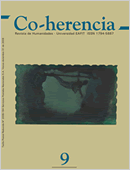The revolutionary doctrine. An interstice between the Century of Light and the chiaroscuro of revolution
Main Article Content
Keywords
Goya, war, horror, painting, reason, French Revolution, Age of Enlightenment
Abstract
The work of Goya like that of Carpentier shows the horrors of the war, in particular those taken place in the “Age of Elightenment”. Both, the painter and the writer, present their pessimistic look of the revolutionary ideals. Carpentier uses in the epigraph of his book “Century of light” the titles of Goya’s work “The disasters of the war” with which the author not only reinforces the idea that the narrator goes capturing little by little on the revolution, but also it facilitates, in the literary analysis, the relationship between painting and literature.
Downloads
Download data is not yet available.
References
Alberti, Rafael (1989) A la pintura. Madrid, Alianza.
Arcia, Jhon(2006) La formación del espíritu científico y el desarrollo de la concienciaen la ciencia. Manizales, Universidad de Manizales.
Balzac, Honorato (1969) “La obra maestra desconocida”. En: La comedia humana. Barcelona, Lito Ediciones.
Benveniste, Emile (1973) Problemas de lingüística general. Argentina, Siglo XXI.
Carpentier, Alejo (1985) Los pasos perdidos. Madrid, Cátedra.
Carpentier, Alejo (1984) El siglo de las luces. Bogotá, Oveja Negra.
De Brand, Isabel (2006) “Los monstruos de la razón, la Revolución Ilustrada en El siglo de las luces de Alejo Carpentier y Los desastres de la guerra de Goya”. En: Presente y Pasado, revista de historia XI(21).
Deleuze, G. y Guattari, F. (1994) ¿Qué es filosofía? Barcelona, Anagrama. Foucault, Michel (1984) La arqueología del saber. México, Siglo XXI.
Fuentes, Carlos (1988) “Alejo Carpentier”. En: El siglo de las luces. Venezuela, Ayacucho.
Libsa (2001) Diccionario de arte, pintores del siglo XIX. Madrid, Libsa.
Goya, Francisco (1975) La obra pictórica completa de Goya. Barcelona, Noguer.
Nordström, Folke (1989) Goya, Saturno y melancolía. Consideraciones sobre el arte de Goya. Madrid, Visor.
Pardo, José Luis (1996) La intimidad. Valencia, Pretexto.
Panofsky, Erwin (2001) El significado en las artes visuales. Madrid, Alianza.
Pérez Blasco, María del C. y Forilliere, Daniel M. (2006) “Museo virtual de Daniely Carmen”. En: http://www.museovirtual@museovirtual.org (agosto de 2007).
Rodríguez, Alexis (1982) Lo barroco y lo real maravilloso en la obra de Alejandro Carpentier. México, Siglo XXI.
Arcia, Jhon(2006) La formación del espíritu científico y el desarrollo de la concienciaen la ciencia. Manizales, Universidad de Manizales.
Balzac, Honorato (1969) “La obra maestra desconocida”. En: La comedia humana. Barcelona, Lito Ediciones.
Benveniste, Emile (1973) Problemas de lingüística general. Argentina, Siglo XXI.
Carpentier, Alejo (1985) Los pasos perdidos. Madrid, Cátedra.
Carpentier, Alejo (1984) El siglo de las luces. Bogotá, Oveja Negra.
De Brand, Isabel (2006) “Los monstruos de la razón, la Revolución Ilustrada en El siglo de las luces de Alejo Carpentier y Los desastres de la guerra de Goya”. En: Presente y Pasado, revista de historia XI(21).
Deleuze, G. y Guattari, F. (1994) ¿Qué es filosofía? Barcelona, Anagrama. Foucault, Michel (1984) La arqueología del saber. México, Siglo XXI.
Fuentes, Carlos (1988) “Alejo Carpentier”. En: El siglo de las luces. Venezuela, Ayacucho.
Libsa (2001) Diccionario de arte, pintores del siglo XIX. Madrid, Libsa.
Goya, Francisco (1975) La obra pictórica completa de Goya. Barcelona, Noguer.
Nordström, Folke (1989) Goya, Saturno y melancolía. Consideraciones sobre el arte de Goya. Madrid, Visor.
Pardo, José Luis (1996) La intimidad. Valencia, Pretexto.
Panofsky, Erwin (2001) El significado en las artes visuales. Madrid, Alianza.
Pérez Blasco, María del C. y Forilliere, Daniel M. (2006) “Museo virtual de Daniely Carmen”. En: http://www.museovirtual@museovirtual.org (agosto de 2007).
Rodríguez, Alexis (1982) Lo barroco y lo real maravilloso en la obra de Alejandro Carpentier. México, Siglo XXI.
